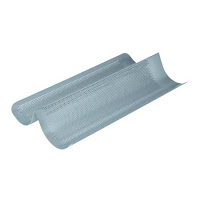 |
| Sourdough French Baguettes |
Note: Many of the FB techniques require a longer fermentation. I believe that using a sourdough starter shortcuts that process which allows you to enjoy flavorful results. Also, there is not need to futz about with sticky dough that clings to your. Rather this dough behaves well, like a well-
trained dog.
Here's the bread that I made just now. I've become a little more adept at making the slashes in the dough. Above... not so much!
Here's the original video that I believe is the fastest way to have an authentic French bread experience. (I see lots of recipes that have oil in them, but I FB is not made with any oil as I understand it).
Below is the recipe as presented above. I used my hand held water sprayer to do the oven hydration as well as a pan at the bottom of the stove that is heated and then pouring water into to create steam.
500g flour *
10g salt
5g fresh yeast **
150g sourdough starter (nicely fed and bubbly) ***
300g cold water
After second rise....bring oven to 475F. Put a pan at the bottom of your oven floor. I used my convection.
Slash your loaves as noted above in the video. I found that a very sharp utility knife (kitchen) works wonderfully. No need for a fancy razor etc.
Brush your loaves or spray with water. Pour water in the bottom pan, being careful of released steam. Place your bread in preheated oven. I found that 22 minutes at 475 convection works well for my oven.
* Can use AP or bread with no noticeable difference in results.
**While the typical measurements of dry yeast v. fresh yeast is .5 of fresh yeast measurement, I used 5g of dry yeast as I was afraid that 2.5 g of yeast was not going to be enough.
*** I measure out 50g of starter and add 50g of flour and 50g of water and let it ferment.
General directions as I have been making it are as follows:
Weigh out all ingredients.
Put flour, salt, yeast, sourdough starter and water in mixer bowl. Use dough hook on mixer and mix on low for 5 minutes, then 6 minutes fast. Dough should be smooth and elastic like chewing gum. You can review the video for the presenter's instructions.
Here are my instructions for my amateur bread making which I believe has professional results. Do get a French bread pan. It will make your life easier. Also, once you make this bread, you will want to make it often. I assure you that this method only takes a few minutes of your time if you are organized.
After kneading dough in machine per above, place dough on board. Make a ball. I don't need any flour as the dough is not sticky like some FB recipes. Place in oiled bowl and let rise at room temperature, covered, to about triple in volume. Punch down on work surface. (Again, I've not needed ANY flour). Weigh dough and cut in half (measure to ensure even loaves).
(You can review this tutorial for mini baguettes: http://www.finecooking.com/recipes/homemade-mini-baguettes.aspx). However, I would note that I do not believe that there is no one right way, though many would lead you to believe so. Rather, so long as you have a method that creates sufficient tension in the bread, then you will be successful--so pay attention to that fact, and develop your technique that accomplishes this.
Pat dough out to a rectangle. Fold top over to middle. Bottom over to middle and each side over to middle. Pat out again. Fold top to middle. Fold bottom to middle. One more fold. On the bottom edge of the dough, use the side of your hand (or fingertips) to make a trench (about 1/2" above bottom edge) along the full length. This will be used to snuggle the top edge of the dough. Fold top edge into this trench. Using the outside of your hand (horizontal to the bread (lenghthwise) or your fingertips, press the top edge of the dough into the trench. You should now have created sufficient tension in your dough to now lengthen by rolling.
Turn over dough with seam side down. Put hands in middle and roll up and outward to lengthen into a loaf. Do this a few times to get the length that you need to place in your Frenchbread pan. It may not be perfect, but with modest practice, you will be able to get a lovely, even rolled bread.
Repeat steps above for second loaf.
Place at room temperature until at least double in size. I put mine in the microwave (I have a large one), and I don't cover. If it is out, cover so as to not dry out. No need for it to be warm like you would do with other bread. Rather, you have a lot going on with the sourdough and the yeast. No need to hurry it. If it rises too much it will tumble out of your pan.
Check for proving (indention does not refill). Bake per above.
Let bread cool.
This bread is the best that I have ever had. This has been echoed by a few of my neighbor guinea pigs. Please try it. It is not hard.










0 comments:
Post a Comment